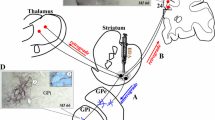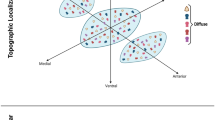Abstract
Previous studies have shown that lowering the GABAergic activity in the sub-pallidal area (SP) in the cat results in the display of oro-facial dyskinesia (OFD). There exists an intense, mutual anatomical connection between the SP and the subthalamic nucleus and the adjoining lateral hypothalamic area (STH). The present study investigated whether the STH is also involved in OFD. Once this turned out to be true (see below), it was investigated whether the SP-specific OFD is funneled via the STH, or vice versa. Bilateral injections of low doses (50–250 ng) of picrotoxin, a non-competitive GABA antagonist, into the STH were found to elicit OFD. This effect which was quantified in terms of numbers of tongue protrusions, was dose-dependent: a bell-shaped dose-response was found (50–500 ng). The OFD elicited by the most effective dose of picrotoxin (250 ng) was significantly antagonized by muscimol, a specific GABAA agonist, in a dose (50 ng) which itself was ineffective, indicating GABA specificity. In addition, it was found that OFD elicited by local injections of picrotoxin (250 ng) into the STH was significantly attenuated by SP injections of the broad spectrum glutamate antagonist kynurenic acid in a dose (1000 ng) which itself was ineffective, but not by muscimol (100 ng), indicating that the STH-elicited OFD needs an intact and functioning glutaminergic, but not GABAergic, transmission process in the SP for its expression. Finally, it was found that OFD elicited by picrotoxin injections (500 ng) into the SP was significantly attenuated by muscimol injections (50 ng) into the STH, indicating that the SP-elicited OFD needs an intact and functioning GABAergic transmission process in the STH for its expression.
Similar content being viewed by others
References
Albin RL, Aldrige W, Young AB, Gilman S (1989) Feline subthalamic nucleus neurons contain glutamate-like but not GABAlike or glycine-like immunoreactivity. Brain Res 491:185–188
Andren PE, Gunne LM (1992) A glutamate hypothesis for tardive dyskinesia. Soc Neurosci Abstr 18 [no. 673.3]: pp 1604
Berendse HW, Groenewegen HJ (1990) The connection of the medial part of the subthalamic nucleus in the rat: evidence for a parallel organization. In: Bernardi G, Carpenter MB, DiChiara G (eds) Basal ganglia III. Plenum Press, New York, pp 89–98
Bergman H, Wichmann T, Delong M (1990) Reversal of experimental parkinsonism by lesions of the subthalamic nucleus. Science 249:1436–1438
Brötchie JM, Crossman AR (1991) D-[3H]Aspartate and [14C]GABA uptake in the basal ganglia of rats following lesions in the subthalamic region suggest a role for excitatory amino acid but not GABA-mediated transmission in subthalamic nucleus efferents. Exp Neurol 113:171–181
Carpenter MB, Batton RR, Carleton SC, Keller JT (1981a) Interconnections and organization of pallidal and subthalamic nucleus neurons in the monkey. J Comp Neurol 197:579–603
Carpenter MB, Carleton SC, Keller JT, Conte P (1981b) Connections of the subthalamic nucleus in the monkey. Brain Res 224:1–29
Cools AR, Struyker-Boudier AJ, Van Rossum JM (1976) Dopamine receptors: selective agonists and antagonists of functionally distinct types within the feline brain. Eur J Pharmacol 37:283–293
Cools AR, Spooren W, Bezemer R, Cuypers E, Jaspers R, Groenewegen H (1989a) Anatomically distinct output channels of the caudate nucleus and oro-facial dyskinesia: critical role of the sub-commissural part of the globus pallidus. Neuroscience. 33:535–542
Cools AR, Spooren W, Cuypers E, Bezemer R, Jaspers R (1989b) Heterogeneous role of neostriatal and mesostriatal pathology in disorders of movement: a review and new facts. In: Crossman AR Sambrook MA (eds) Neural mechanisms in disorders of movement. Libbey, London, pp 111–119
Crossman AR (1987) Primate models of dyskinesia: the experimental approach to the study of basal ganglia-related involuntary movement disorders. Neuroscience 21:1–40
Crossman AR, Sambrook MA, Jackson A (1984) Experimental hemichorea/hemiballismus in the monkey. Studies of the intracerebral site of action of a drug induced dyskinesia. Brain 107:579–596
Desban M, Gauchy C, Kemel L, Besson MJ, Glowinski J (1989) Three-dimensional organization of the striosomal compartment and patchy distribution of striatonigral projections in the matrix of the cat caudate nucleus. Neuroscience. 33:535–293
Ellison G, See R, Levin E, Kinney J (1987) Tremorous movements in rats administered chronic neuroleptics. Psychopharmacology 92:122–126
Fibiger HC, Lloyd KG (1984) Neurobiological substrates of tardive dyskinesia: the GABA hypothesis. Trends Neurosci 7:462–464
Fonnum F, Grofova I, Rinvik E (1978) Origin and distribution of glutamate decarboxylase in the nucleus subthalamicus of the cat. Brain Res 153:370–374
Groenewegen HJ, Russchen FT (1984) Organization of the efferent projections of the nucleus accumbens to pallidal, hypothalamic and mesencephalic structures: a tracing and immunohistochemical study in the cat. J Comp Neurol 223:347–367
Gunne LM, Haggstrom JE, Sjoquist B (1984) Association with persistent neuroleptic-induced dyskinesia of regional changes in brain GABA. Nature 309:347–349
Haber SN, Lynd E, Mitchell SJ (1993) The organization of the descending ventral pallidal projections in the monkey. J Comp Neurol 329:111–128
Hazrati LN, Parent A (1992) Convergence of subthalamic and striatal efferents at pallidal level in primates: an anterograde double-labeling study with biocytin and PHA-L. Brain Res 569:336–340
Kim R, Nakano K, Jayaraman A, Carpenter MB (1976) Projections of the globus pallidus and adjacent structures: an autoradiographic study in the monkey. J Comp Neurol 169:263–290
Klawans HL, Goetz CG, Perlik S (1980) Tardive dyskinesia: a review and update. Am J Psychiatry 137:900–907
Koshikawa N, Aoki S, Hiruta M, Koboyashi M, Tsuboi Y, Iwata K, Sumino R, Stephenson JD (1989) Effects of intrastriatal injections of selective dopamine D-1 and D-2 agonists and antagonists on jaw movements in rats. Eur J Pharmacol 163:227–236
Parent A, Hazrati LN (1993) Anatomical aspects of information processing in primate basal ganglia. Trends Neurosci 16:111–116
Prinssen E, Koenen P, Heeren D, Cools AR (1992) Jaw muscle activity, the nucleus accumbens and dopaminergic agonists: a new approach. Brain Res Bull 28:775–780
Robledo P, Feger J (1990) Excitatory influence of rat subthalamic nucleus to substantia nigra pars reticulata and the pallidal complex: electrophysiological data. Brain Res 518:47–54
Rouzaire-Dubois B, Hammond C, Hammond B, Feger J (1980) Pharmacological blockade of the globus pallidus-induced inhibitory response of subthalamic cells in the rat. Brain Res 200:321–329
Russchen FT, Amaral DG, Price JL (1985) The afferent connections of the substantia innominata in the monkey,Macaca fascicularis. J Comp Neurol 256:175–210
Ryan LJ, Clark KB (1991) The role of the subthalamic nucleus in the response of glubus pallidus neurons to stimulation of the prelimbic and agranular frontal cortices in rats. Exp Brain Res 86:641–651
Schonecker M (1957) Ein eigentumliches syndrome in oralen bereich bei megaphon applikation. Nervenartzt 28:35
Smith Y, Hazrati LN, Parent A (1990) Efferent projections of the subthalamic nucleus in the squirel monkey as studied by the PHA-L anterograde tracing method. J Comp Neurol 24:306–323
Smith Y, Parent A (1988) Neurons of the subthalamic nucleus in primates display glutamate but not GABA immunoreactivity. Brain Res 453:353–356
Snider RS, Niemer WT (1964) A stereotactic atlas of the cat brain, University of Chicago Press, London, Chicago
Spooren WPJM (1992) The neuronal substrate of oro-facial dyskinesia in cats: a neuro-pharmacological and neuro-anatomical study. PhD thesis, Krips Repro, Meppel, The Netherlands
Spooren WPJM, Cuypers E, Cools AR (1989) Oro-facial dyskinesia and the sub-commissural part of the globus pallidus in the cat: role of acetylcholine and its interaction with GABA. Psychopharmacology 99:381–385
Spooren WPJM, Groenewegen HJ, Cools AR (1991a) Subregions of the caudate nucleus and their in- and output channels in orofacial dyskinesia: a behavioural and retrograde tracing study in the cat. Brain Res 539:85–93
Spooren WPJM, Piosik PA, Cools AR (1991b) Dopamine D1 receptors in the sub- commissural part of the globus pallidus and their role in oro-facial dyskinesia in cats. Eur J Pharm 204:217–222
Spooren WPJM, Veening JG, Groenewegen HJ, Cools AR (1991c) Efferent connections of the striatopallidal and amygdaloid components of the substantia innominata in the cat: Projections to the nucleus accumbens and caudate nucleus. Neuroscience 44:431–447
Spooren WPJM, Mulders WHAM, Veening JG, Cools AR (1993a) The substantia innominata complex and the peripeduncular nucleus in oro-facial dyskinesia: a pharmacological and anatomical study in the cat. Neuroscience 52:17–25
Spooren WPJM, Veening JG, Cools AR (1993b) Descending efferent connections of the sub-pallidal areas in the cat: projections to the subthalamic nucleus, the hypothalamus and the midbrain. Synapse 15:104–123
Turski L, Klockgether T, Turski WA, Schwarz M, Sontag K (1990) Blockade of excitatory neurotransmission in the globus pallidus induces rigidity and akinesia in the rat: implications for excitatory neurotransmission in pathogenesis of Parkinson's disease. Brain Res 512:125–131
Waddington JL (1989) Schizophrenia, affective psychoses, and other disorders treated with neuroleptic drugs: the enigma of tardive dyskinesia, its neurobiological determinants, and conflict of paradigms. Int Rev Neurobiol 31:297–353
Author information
Authors and Affiliations
Rights and permissions
About this article
Cite this article
Spooren, W.P.J.M., Helfrich, S.E.M. & Cools, A.R. Interactions of the subthalamic nucleus and the subpallidal area in oro-facial dyskinesia: role of GABA and glutamate. Psychopharmacology 119, 20–26 (1995). https://doi.org/10.1007/BF02246049
Received:
Revised:
Issue Date:
DOI: https://doi.org/10.1007/BF02246049




